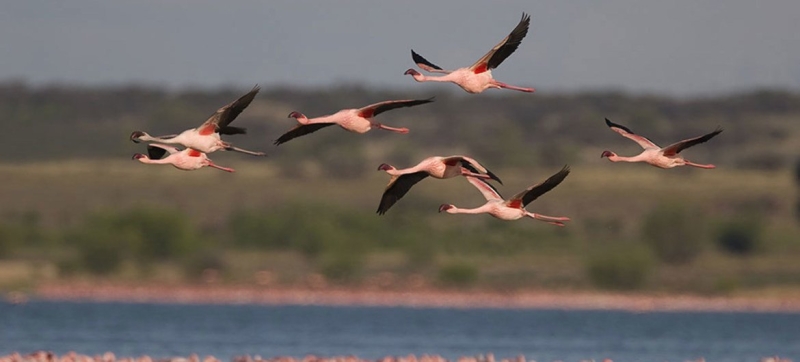
Flamingos are among the migratory birds that the UN calls for protection from the effects of climate change UN sounds alarm: number of migratory wild animal species is declining Climate and Environment
Forty-four percent of migratory wildlife species are in decline, and one in five species is at risk of extinction. These alarming trends are highlighted by the first-ever study of migratory animals.
The report, published Monday, was prepared in accordance with the requirements of the Convention on the Conservation of Migratory Species of Wild Animals. The publication is timed to coincide with the conference, which opened today in Samarkand.
97 percent of fish species are under threat
So, Populations of 44 percent of all species are declining, with one in five at risk of extinction. The situation with fish is especially alarming – almost all species (97 percent) of fish included in the Convention’s list are endangered.
The risk of extinction of migratory species, including those not listed, is growing around the world.
Half (51 percent) of the key biodiversity areas identified as important for migratory animals do not have protected status, and 58 percent of monitored areas are affected by human activities.
Anthropogenic factors
The two biggest threats are overexploitation and habitat loss due to human activities. Three out of four species are affected by habitat loss, degradation and fragmentation, and seven out of ten species are affected by overexploitation.
Climate change, pollution and invasive species are also impacting significant impacts on migratory species.
Globally, 399 threatened or critically endangered migratory species are not currently listed by the Convention.
Read also:
INTERVIEW | Migrating birds know no boundaries
“Today’s report shows us clearly that irresponsible human activity is jeopardizing the future of migratory species,” said Inger Andersen, Executive Director of the United Nations Environment Programme, said.
The results obtained indicate the scale of change in the environment. According to the head of UNEP, this information is necessary to take measures to protect the ecosystems of our planet. “Given the situation for many of these animals, we cannot afford to delay and must work together to implement [the report’s authors’] recommendations.”
Migratory Animals
Billions of animals migrate annually over land, oceans and air, crossing country borders and continents, and some of them travel thousands of kilometers in search of a favorable environment.
Migratory species play an important role in maintaining the world’s ecosystems – they pollinate plants, transport key nutrients, hunt pests and help store carbon.
Joint work of scientists from different countries
The report was prepared by environmental scientists from the World Conservation Monitoring Center of the UN Environment Program with the support of a number of other relevant organizations.
It focuses on the 1,189 species of animals that the parties to the Convention have recognized as being in need of international protection and included in the corresponding list. At the same time, the authors of the study also additionally analyzed the status of more than three thousand migratory species not included in this list.
Convention on the Conservation of Migratory Species of Wild Animals
The Convention on the Conservation of Migratory Species of Wild Animals (also known as the CMS or Bonn Convention) aims to conserve terrestrial and marine migratory animals, as well as migratory birds, throughout their range. This is an international treaty concluded in 1979 within the framework of the United Nations Environment Program. Since the signing of the Convention, the number of its parties has gradually grown and now amounts to 133 countries in Africa, Central and South America, Asia, Europe and Oceania.
Species listed in the Convention are threatened with extinction throughout all or most of their range or require coordinated international action to improve their conservation status.
Amy Frankel, Executive Secretary of the Convention explained that migratory species use a variety of specific habitats at different times in their life cycle. They regularly travel thousands of kilometers to reach these places. “They face enormous challenges and threats along their journey and at their destinations where they breed or feed,” she continued. “When species cross national borders, their survival depends on the efforts of all countries involved.”
To protect migratory animals, the international community must act together, Frenkel said.
Over the past 30 years, 70 listed migratory species, including the steppe eagle, vulture and wild camel, have become threatened with extinction. 14 species, on the other hand, are in a better position than before thanks to measures to protect them. These include blue and humpback whales, the white-tailed eagle and the black-faced spoonbill.
Most alarmingly, nearly all fish species listed by the Convention, including migratory sharks, rays and sturgeons, face a high risk of extinction, with their populations declining by 90 percent since the 1970s.
399 migratory species not listed by the Convention are also at risk of extinction.
Recovery of populations is possible
The report’s authors emphasize that recovery of populations and species is possible, and provide examples of successful policy changes , both locally and internationally. For example, coordinated efforts in Cyprus have reduced illegal bird hunting by 91 percent, and extremely successful comprehensive conservation and restoration efforts in Kazakhstan have saved the saiga from extinction.
Read also:
PLOT Kazakhstan saves the “ghost of the mountains” – the snow leopard
Specialists who worked on the report propose expanding efforts to combat illegal and irresponsible capture of migratory species, more actively combating climate change, as well as environmental pollution . They also recommend expanding the list of the Convention.
Conference in Samarkand
The publication of the report is timed to coincide with the UN Conference on Wildlife Conservation, which started today in Samarkand, Uzbekistan. This is the first conference of the parties to a global environmental treaty to take place in Central Asia, a region home to many migratory species, including saigas, snow leopards, and many species of migratory birds.
